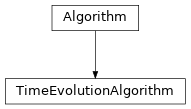TimeEvolutionAlgorithm¶
full name: tenpy.algorithms.algorithm.TimeEvolutionAlgorithm
parent module:
tenpy.algorithms.algorithmtype: class
Inheritance Diagram

Methods
|
Initialize self. |
Return necessary data to resume a |
|
Resume a run that was interrupted. |
|
Perform a real-time evolution of |
Class Attributes and Properties
|
-
class
tenpy.algorithms.algorithm.TimeEvolutionAlgorithm(psi, model, options, *, resume_data=None)[source]¶ Bases:
tenpy.algorithms.algorithm.AlgorithmCommon interface for (real) time evolution algorithms.
- Parameters
psi – Tensor network to be updated by the algorithm.
model (
Model| None) – Model with the representation of the hamiltonian suitable for the algorithm. None for algorithms which don’t require a model.options (dict-like) – Optional parameters for the algorithm. In the online documentation, you can find the correct set of options in the Config Index.
resume_data (None | dict) – By default (
None) ignored. If a dict, it should contain the data returned byget_resume_data()when intending to continue/resume an interrupted run.
Options
-
config
TimeEvolutionAlgorithm¶ option summary Minimal time step by which to evolve.
Number of time steps `dt` to evolve by in :meth:`run`. [...]
Initial value for :attr:`evolved_time`.
trunc_params (from Algorithm) in Algorithm
Truncation parameters as described in :cfg:config:`truncation`.
-
option
start_time: float¶ Initial value for
evolved_time.
-
option
dt: float¶ Minimal time step by which to evolve.
-
option
-
evolved_time¶ Indicating how long psi has been evolved,
psi = exp(-i * evolved_time * H) psi(t=0). Not that the real-part of t is increasing for a real-time evolution, while the imaginary-part of t is decreasing for a imaginary time evolution.- Type
float | complex
-
get_resume_data()[source]¶ Return necessary data to resume a
run()interrupted at a checkpoint.At a
checkpoint, you can savepsi,modelandoptionsalong with the data returned by this function. When the simulation aborts, you can resume it using this saved data with:eng = AlgorithmClass(psi, model, options, resume_data=resume_data) eng.resume_run(resume_data)
An algorithm which doesn’t support this should override resume_run to raise an Error.
- Returns
resume_data – Dictionary with necessary data (apart from copies of psi, model, options) that allows to continue the simulation from where we are now.
- Return type
-
resume_run()[source]¶ Resume a run that was interrupted.
In case we saved an intermediate result at a
checkpoint, this function allows to resume therun()of the algorithm (after re-initialization with the resume_data). Since most algorithms just have a while loop with break conditions, the default behaviour implemented here is to just callrun().